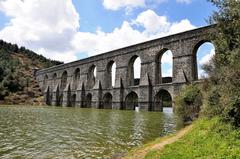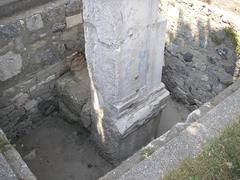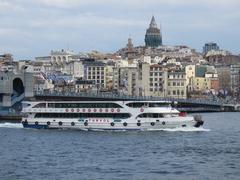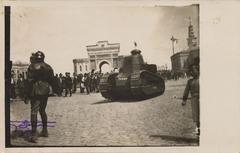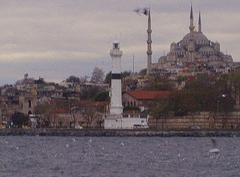
Comprehensive Guide to Visiting Güzelce Su Kemeri, Istanbul, Türkiye
Date: 19/07/2024
Introduction
Nestled in the vibrant city of Istanbul, Türkiye, the Güzelce Su Kemeri, also known as the Güzelce Aqueduct, stands as a testament to the architectural brilliance and engineering ingenuity of the Byzantine and Ottoman empires. This historical monument, part of Istanbul’s rich tapestry, invites tourists, historians, and architecture enthusiasts to explore its majestic arches and delve into its storied past. Constructed during the 6th century under the reign of Byzantine Emperor Justinian I, the aqueduct underwent significant restoration and expansion during the 16th century under Ottoman Sultan Suleiman the Magnificent (Istanbul Metropolitan Municipality). Spanning approximately 625 meters and reaching 29 meters at its tallest point, the Güzelce Su Kemeri exemplifies the advanced engineering skills of its time and plays a crucial role in Istanbul’s historical and cultural narrative (ArchNet).
Table of Contents
- Introduction
- Origins and Construction
- Architectural Significance
- Role in Water Supply
- Visiting Hours and Tickets
- Travel Tips and Nearby Attractions
- Restoration and Preservation
- Historical Context
- Cultural Impact
- Modern-Day Relevance
- FAQ
- Conclusion
Origins and Construction
The Güzelce Su Kemeri dates back to the 6th century, constructed during the reign of Byzantine Emperor Justinian I. It was an integral component of a network designed to supply water to Constantinople, now known as Istanbul. The aqueduct saw significant restoration and expansion under the Ottoman Empire, particularly during the 16th century under Sultan Suleiman the Magnificent (Istanbul Metropolitan Municipality).
Architectural Significance
Spanning approximately 625 meters and reaching 29 meters at its tallest point, the Güzelce Su Kemeri features a dual-tiered design with larger arches on the lower tier and smaller ones on the upper tier. This design enhances its aesthetic appeal and structural stability. Constructed using local limestone and brick, the aqueduct exemplifies the materials and techniques of the Byzantine and Ottoman periods (ArchNet).
Role in Water Supply
Originally designed to transport water from the Belgrade Forest to Constantinople, the aqueduct played a crucial role in the city’s water supply system, which included reservoirs, cisterns, and other aqueducts. This system ensured a continuous supply of fresh water for drinking, bathing, and irrigation, even during droughts or sieges (Turkish Cultural Foundation).
Visiting Hours and Tickets
The Güzelce Su Kemeri is open to visitors daily from 9:00 AM to 6:00 PM. Admission is free, making it an accessible site for all tourists. Guided tours are available for those interested in a more in-depth exploration of the aqueduct’s history and architecture. For up-to-date information on visiting hours and any potential closures, refer to the Istanbul Tourism Board.
Travel Tips and Nearby Attractions
Visitors to the Güzelce Su Kemeri should wear comfortable walking shoes and bring a hat and sunscreen, especially during the summer months. Nearby attractions include the Belgrade Forest, a perfect spot for nature lovers, and the historic neighborhoods of Istanbul, where you can immerse yourself in the city’s rich culture and history.
Restoration and Preservation
Significant restoration work has been undertaken over the centuries to preserve the Güzelce Su Kemeri. Notable efforts include those by the Ottoman architect Mimar Sinan in the 16th century and more recent initiatives aimed at maintaining its status as a cultural heritage site (UNESCO).
Historical Context
The importance of the Güzelce Su Kemeri can be understood within the broader context of Istanbul’s history. Constantinople’s role as a major political, economic, and cultural hub during the Byzantine era necessitated advanced infrastructure. Following the Ottoman conquest in 1453, the city continued to flourish, with further investments in infrastructure (History of Istanbul).
Cultural Impact
Beyond its engineering marvel, the Güzelce Su Kemeri symbolizes Istanbul’s rich and diverse history. It has inspired numerous works of art, literature, and scholarship, and today remains a popular tourist attraction (Istanbul Guide).
Modern-Day Relevance
Today, the Güzelce Su Kemeri continues to captivate historians, architects, and tourists. It is a focal point for educational programs and cultural events aimed at promoting the preservation of historical sites. Efforts to integrate the aqueduct into Istanbul’s urban narrative ensure its appreciation by future generations (Istanbul Tourism Board).
FAQ
Q: Are there any entrance fees for the Güzelce Su Kemeri?
A: No, entrance to the Güzelce Su Kemeri is free.
Q: What are the opening hours?
A: The aqueduct is open daily from 9:00 AM to 6:00 PM.
Q: Are guided tours available?
A: Yes, guided tours are available for a more comprehensive understanding of the site.
Conclusion
The Güzelce Su Kemeri is more than just an architectural marvel; it is a symbol of Istanbul’s historical and cultural legacy, reflecting the ingenuity and resilience of the civilizations that have shaped the city. From its inception in the Byzantine era to its expansion under the Ottoman Empire, this aqueduct has been integral to the city’s water supply system and public health infrastructure. Its dual-tiered design, constructed using local limestone and brick, highlights the advanced construction techniques of the time, making it a significant historical monument (Turkish Cultural Foundation). Today, the aqueduct continues to captivate historians, architects, and tourists, serving as a focal point for educational programs and cultural events aimed at promoting the preservation of historical sites (UNESCO). By visiting the Güzelce Su Kemeri, one not only steps back into a rich historical past but also contributes to the ongoing appreciation and preservation of Istanbul’s cultural heritage for future generations (Istanbul Tourism Board).
References
- Exploring Güzelce Su Kemeri - History, Visiting Hours, and Tickets, 2024, Istanbul Metropolitan Municipality https://www.ibb.istanbul
- Exploring Güzelce Su Kemeri - History, Visiting Hours, and Tickets, 2024, ArchNet https://www.archnet.org
- Exploring Güzelce Su Kemeri - History, Visiting Hours, and Tickets, 2024, Turkish Cultural Foundation https://www.turkishculturalfoundation.org
- Güzelce Su Kemeri - Visiting Hours, Tickets, and Historical Significance in Istanbul, 2024, UNESCO https://whc.unesco.org
- Güzelce Su Kemeri - Visiting Hours, Tickets, and Historical Significance in Istanbul, 2024, Istanbul Tourism Board https://www.istanbultourismboard.com
